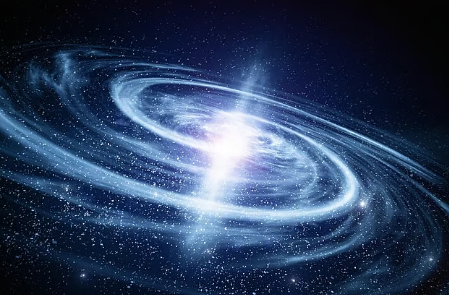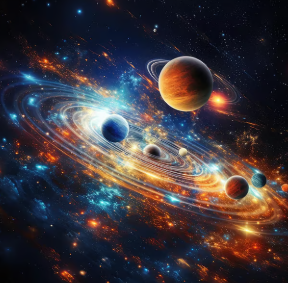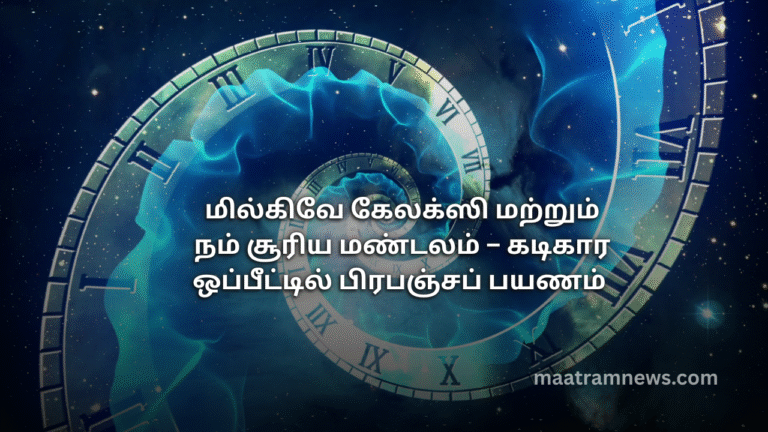மில்கிவே கேலக்ஸி மற்றும் நம் சூரிய மண்டலம் – கடிகார ஒப்பீட்டில் பிரபஞ்சப் பயணம்
🌌 மில்கிவே கேலக்ஸி என்றால் என்ன?
மில்கிவே கேலக்ஸி (Milky Way Galaxy) என்பது நம்முடைய சூரிய மண்டலமும் (Solar System), அதனுடன் கோடிக்கணக்கான நட்சத்திரங்களும், வாயுக்களும், தூசிகளும், இருண்ட பொருள்களும் (Dark Matter) சேர்ந்து உருவான ஒரு பெரிய விண்மீன் கூட்டம் (Galaxy) ஆகும்.
மில்கிவே கேலக்ஸியில் சுமார் 1,00,000 ஒளியாண்டுகள் (Light Years) பரப்பளவு கொண்ட (1 ஒளியாண்டு = ஒளி 1 வருடம் செல்லும் தூரம் ≈ 9.46 டிரில்லியன் கி.மீ.) சுமார் 100 – 400 பில்லியன் நட்சத்திரங்கள் உள்ளன.
நம் சூரிய மண்டலம், மில்கிவே கேலக்ஸியின் மையத்திலிருந்து சுமார் 27,000 ஒளியாண்டுகள் தொலைவில், “Orion Arm” எனப்படும் பகுதியின் ஓரத்தில் உள்ளது.
மில்கிவே கேலக்ஸியின் மையத்தில் ஒரு பெரிய கருந்துளை (Supermassive Black Hole) உள்ளது. இதற்கு “Sagittarius A*” என்று பெயர்.

☀️ சூரிய மண்டலம் என்றால் என்ன?
சூரிய மண்டலம் (Solar System) என்பது சூரியனைச் சுற்றி சுழலும் விண்வெளி குடும்பம் ஆகும்.
இதில் சூரியன், கிரகங்கள், துணைக்கோள்கள், வால்நட்சத்திரங்கள், ஆஸ்ட்ராய்ட்கள், விண்கற்கள், தூசி மற்றும் வாயுக்கள் ஆகியவை அடங்கும்.
🌞 சூரியன்
- சூரியன் தான் சூரிய மண்டலத்தின் மையம்.
- இது ஒரு நட்சத்திரம், மற்றும் முழு மண்டலத்திற்கும் ஒளி மற்றும் வெப்பத்தின் மூலாதாரம்.
🪐 சூரியனைச் சுற்றும் 8 கிரகங்கள்
- புதன் (Mercury) – சூரியனுக்கு அருகிலான மிகச் சிறிய கிரகம்.
- சுக்கிரன் (Venus) – மிகவும் சூடான கிரகம்.
- பூமி (Earth) – உயிர்கள் வாழும் ஒரே கிரகம்.
- செவ்வாய் (Mars) – “சிகப்பு கிரகம்” என்று அழைக்கப்படுகிறது.
- வியாழன் (Jupiter) – மிகப்பெரிய கிரகம்.
- சனி (Saturn) – அழகான வளையங்கள் (rings) கொண்ட கிரகம்.
- யுரேனஸ் (Uranus) – பக்கவாட்டில் சுழலும் விசித்திர கிரகம்.
- நெப்தியூன் (Neptune) – மிகத் தொலைவில் உள்ள குளிர்ந்த கிரகம்.

🌙 சூரிய மண்டலத்தின் துணைக்கோள்கள்
🌍 பூமி (Earth)
1 துணைக்கோள் – சந்திரன் (Moon)
🪐 புதன் (Mercury)
0 துணைக்கோள் – சந்திரன் இல்லை
🔴 செவ்வாய் (Mars)
2 துணைக்கோள்கள் – போபோஸ் (Phobos), டெய்மோஸ் (Deimos)
🟤 வியாழன் (Jupiter)
79 துணைக்கோள்கள் (தற்சமயம் அறியப்பட்டவை)
முக்கியமானவை: ஐரோப்பா (Europa), கெனிமீட் (Ganymede – சூரிய மண்டலத்தின் மிகப்பெரிய துணைக்கோள்), கல்லிஸ்டோ (Callisto), ஐஒ (Io)
💛 சனி (Saturn)
83 துணைக்கோள்கள் (உறுதி செய்யப்பட்டவை)
முக்கியமானது: டைட்டன்
💚 யுரேனஸ் (Uranus)
27 துணைக்கோள்கள்
பெரும்பாலானவை ஷேக்ஸ்பியர் நாடக கதாபாத்திரங்களின் பெயர்களால் அழைக்கப்படுகின்றன (உதாரணம்: மிராண்டா, ஏரியல், அம்ப்ரியல்).
💙 நெப்தியூன் (Neptune)
14 துணைக்கோள்கள்
மிகப்பெரியது: ட்ரைட்டன் (Triton – பின்திசையில் சுழல்கிறது).
✨ சுருக்கமாக
மொத்தம்: சூரிய மண்டலத்தில் 200-க்கும் மேற்பட்ட துணைக்கோள்கள் கண்டுபிடிக்கப்பட்டுள்ளன.
அதிக துணைக்கோள்கள்: சனி (83)
குறைந்தது: புதன்
மிகப்பெரிய துணைக்கோள்: கெனிமீட் (Ganymede – வியாழன் சுற்றும்).
☄️ மற்ற விண்வெளிப் பொருட்கள்
- ஆஸ்ட்ராய்ட்கள் (Asteroids): சின்ன சின்ன கற்கள், குறிப்பாக “Asteroid Belt” பகுதியில்.
- வால்நட்சத்திரங்கள் (Comets): பனி மற்றும் தூசிகளால் ஆனவை, வால் போல நீண்டு தெரியும்.
- மீட்டியராய்ட்கள் (Meteoroids): விண்கற்கள். பூமிக்குள் விழும்போது “விண்மீன்” (Shooting Star) போல தெரியும்.
🌌 மில்கிவே கேலக்ஸி மற்றும் நம் சூரிய மண்டலம் – கடிகார ஒப்பீட்டில் பிரபஞ்சப் பயணம்
நாம் வாழும் பூமி, சூரியன், சந்திரன் எல்லாம் சேர்ந்திருக்கும் அமைப்பு தான் சூரிய மண்டலம். ஆனால், இது தான் முழுப் பிரபஞ்சம் என்று எண்ணக்கூடாது. உண்மையில் நம் சூரிய மண்டலம், மில்கிவே கேலக்ஸி எனப்படும் பிரம்மாண்ட விண்மீன் கூட்டத்தின் ஒரு சிறிய பகுதி மட்டுமே.
🚀 சூரிய மண்டலத்தின் அதிவேகப் பயணம்
விண்வெளியில் நம் சூரிய மண்டலம் சும்மா நிற்கவில்லை; அது நம்ப முடியாத அளவுக்கு மிக வேகமாக நகர்கிறது:
மணிக்கு 8,28,000 கி.மீ
நிமிடத்திற்கு 13,800 கி.மீ
வினாடிக்கு 230 கி.மீ
இந்த வேகத்தில் கூட, நம் சூரிய மண்டலம் மில்கிவேயை முழுமையாக ஒரு முறை சுற்ற 220 மில்லியன் ஆண்டுகள் எடுக்கிறது!
⏰ “கேலக்ஸி கடிகாரம்” – நேர ஒப்பீடு
ஒரு சுவர்க் கடிகாரத்தை கற்பனை செய்யுங்கள்.
அந்தக் கடிகாரமே மில்கிவே, அதில் சூரிய மண்டலம் சுற்றிக்கொண்டிருக்கும் ஒரு புள்ளி.
வினாடி முள் ஒரு வினாடி நகர 5,080 ஆண்டுகள் ஆகும்.
நிமிட முள் ஒரு நிமிடம் நகர 3,05,000 ஆண்டுகள் ஆகும்.
மணி முள் ஒரு மணி நகர 18.3 மில்லியன் ஆண்டுகள் ஆகும்.
🦖 பரிணாமம் – கடிகாரத்தில்
3 மணி (55 மில்லியன் ஆண்டுகள்): டைனோசர்கள் பூமியை ஆட்சி செய்த காலம்.
6 மணி (110 மில்லியன் ஆண்டுகள்): பாலூட்டிகள் (Mammals) தோன்றிய தருணம்.
9 மணி (165 மில்லியன் ஆண்டுகள்): டைனோசர்கள் அழிந்த தருணம்.
11:59:59 (220 மில்லியன் ஆண்டுகள்): மனிதர்கள் தோன்றிய காலம்.
👉 அதாவது, இந்த பிரபஞ்சக் கடிகாரத்தில் டைனோசர்கள் சுமார் 30 நிமிடங்கள் மட்டுமே வாழ்ந்தனர்.
ஆனால் மனிதர்கள்? வெறும் 1 வினாடி தான்!
🌍 சிந்திக்க வைக்கும் உண்மை
இது நமக்கு இரண்டு பெரிய உண்மைகளை உணர்த்துகிறது:
பிரபஞ்சம் எவ்வளவு பிரமாண்டமானது – மில்கிவேவில் சுமார் 100 முதல் 400 பில்லியன் நட்சத்திரங்கள் உள்ளன. அவற்றில் ஒன்றுதான் நம் சூரியன்.
வாழ்வின் நொடித்தன்மை – உயிரினங்கள் மிக வேகமாக தோன்றி அழிகின்றன. நம் மனித வாழ்வு, இந்த பிரபஞ்ச அளவுகோலில், ஒரு சிறிய கணம் மட்டுமே.
🌠 சமீபத்திய ஆராய்ச்சிகள்
🔭 2023-ல் NASA மற்றும் ESA வானியலாளர்கள் தெரிவித்தது:
நம் சூரிய மண்டலம் தற்போது மில்கிவேயின் ஒரியன் ஆர்மில் (Orion Arm) சுமார் 27,000 ஒளியாண்டுகள் தூரத்தில், கேலக்ஸியின் மையத்திலிருந்து விலகி உள்ளது.
ஒவ்வொரு 220 மில்லியன் ஆண்டுகளுக்கும், நம் சூரிய மண்டலம் ஒரு முறை கேலக்ஸி மையத்தைச் சுற்றுகிறது.
விஞ்ஞானிகள் கணிக்கிறார்கள்: இன்னும் சுமார் 4 பில்லியன் ஆண்டுகளில், மில்கிவே கேலக்ஸி “அண்ட்ரோமெடா கேலக்ஸி”யுடன் மோதிக்கொண்டு, புதிய பிரம்மாண்ட கேலக்ஸி உருவாகும்.
💡 நம் வாழ்க்கைக்கான பாடம்
சண்டைகள், பேராசைகள், குற்ற உணர்வுகள் எல்லாம் பிரபஞ்ச அளவுகோலில் அற்பமானவை.
நாம் வாழும் அந்த ஒரே ஒரு வினாடியை அர்த்தமுள்ளதாக மாற்றுவது தான் நம் கடமை.
🌱 அன்பு, அறிவு, நன்மை – இவை தான் அந்த ஒரு வினாடியை பிரகாசமாக்கும் சக்தி.
மேலதிக தகவல்களுக்கு மாற்றம் செய்திகள் இணையத்தளத்தினுள் பிரவேசியுங்கள்.
மேலதிக தகவல்களை உடனுக்குடன் பெற்றுக்கொள்ள மாற்றம் செய்திகள் முகநூல் பக்கத்தை பின்தொடரவும்.
The Milky Way Galaxy and Our Solar System – Clockwise Cosmology
🌌 What is the Milky Way Galaxy?
The Milky Way Galaxy is a vast collection of stars, gases, dust, dark matter, and other celestial objects — including our Solar System.
- Size: About 100,000 light years across (1 light year = distance light travels in one year ≈ 9.46 trillion km)
- Stars: Contains around 100–400 billion stars.
- Solar System’s Location: Our Solar System is about 27,000 light years away from the center of the Milky Way, located on the edge of a region called the Orion Arm.
- Center: At the core of the Milky Way lies a supermassive black hole called Sagittarius A*.
☀️ What is the Solar System?
The Solar System is a cosmic family that revolves around the Sun.
It includes the Sun, planets, moons, comets, asteroids, meteoroids, dust, and gases.
🌞 The Sun
- The Sun is the center of the Solar System.
- It is a star and the main source of light and heat for all the planets.
🪐 The 8 Planets Around the Sun
- Mercury – Smallest planet, closest to the Sun.
- Venus – The hottest planet.
- Earth – The only planet known to support life.
- Mars – Known as the “Red Planet.”
- Jupiter – The largest planet.
- Saturn – Famous for its beautiful rings.
- Uranus – A tilted planet that rotates sideways.
- Neptune – The cold, distant planet.
🌙 Moons of the Solar System
🌍 Earth
- 1 moon – The Moon
🪐 Mercury
- 0 moons
🪐 Venus
- 0 moons
🔴 Mars
- 2 moons – Phobos, Deimos
🟤 Jupiter
- 79 moons (so far discovered)
- Notable: Europa, Ganymede (largest moon in the Solar System), Callisto, Io
💛 Saturn
- 83 moons (confirmed)
- Notable: Titan (a moon with its own atmosphere)
💚 Uranus
- 27 moons
- Mostly named after Shakespearean characters (e.g., Miranda, Ariel, Umbriel).
💙 Neptune
- 14 moons
- Largest: Triton (orbits in the opposite direction).
✨ Summary
- Total: Over 200 moons in the Solar System.
- Most moons: Saturn (83)
- Fewest moons: Mercury & Venus (0)
- Largest moon: Ganymede (of Jupiter).
☄️ Other Celestial Objects
- Asteroids: Small rocky bodies, mostly in the “Asteroid Belt.”
- Comets: Made of ice and dust, with bright tails.
- Meteoroids: Space rocks; when they fall to Earth’s atmosphere, they appear as “shooting stars.”
🌌 Milky Way Galaxy & Our Solar System – The Cosmic Clock
Our Earth, Sun, and Moon belong to the Solar System. But the Solar System is just a tiny part of the Milky Way Galaxy.
🚀 The Solar System’s Incredible Speed
Our Solar System is moving rapidly through space:
- 828,000 km/hour
- 13,800 km/minute
- 230 km/second
Even at this speed, it takes about 220 million years to complete one orbit around the Milky Way.
⏰ “Galaxy Clock” – Time Comparison
Imagine a wall clock as the Milky Way. The Solar System is like a point moving around it.
- Second hand: 1 second = 5,080 years
- Minute hand: 1 minute = 305,000 years
- Hour hand: 1 hour = 18.3 million years
🦖 Evolution on the Galactic Clock
- 3:00 (55 million years): Dinosaurs dominated Earth.
- 6:00 (110 million years): Mammals appeared.
- 9:00 (165 million years): Dinosaurs went extinct.
- 11:59:59 (220 million years): Humans appeared.
👉 Dinosaurs lived for about 30 minutes on this clock.
Humans? Just 1 second!
🌍 A Thought-Provoking Truth
This reveals two major insights:
- The Universe’s vastness – The Milky Way contains 100–400 billion stars; our Sun is just one of them.
- The Fragility of Life – Species appear and disappear quickly. Human life is just a fleeting moment in the cosmic scale.
🌠 Recent Discoveries
🔭 In 2023, NASA & ESA astronomers shared:
- The Solar System is currently in the Orion Arm, about 27,000 light years from the Milky Way’s center.
- Every 220 million years, it completes one orbit of the galaxy.
- In about 4 billion years, the Milky Way will collide with the Andromeda Galaxy, forming a new, giant galaxy.
💡 Life Lesson
Conflicts, greed, and guilt are insignificant on a cosmic scale.
What truly matters is making our one second in this cosmic clock meaningful.
🌱 Love, knowledge, and kindness are what can light up that single moment.



